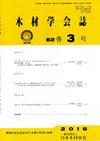Strength and Stress of the Strapped Adhesive Joints made of Hinoki Cypress and Bamboo Plate under Tensile Loadings
IF 0.1
4区 农林科学
Q4 MATERIALS SCIENCE, PAPER & WOOD
引用次数: 0
Abstract
In the present study, new high-performance strapped adhesive plates comprising of hinoki cypress (Chamaecyparis obtusa) and bamboo (Phyllostachys heterocycla) were investigated. Such plates are expected to find applications in making furniture or house wall construction. Two test set-up were performed, single-strap joint and double-strap joint. In the single-strap joint set-up, one bamboo plate was glued to one side of two abutting hinoki plates. Two thickness bamboo plate variables were tested, using 4 and 2 mm. On the other hand, in the double-strap joint set-up, two identical size bamboo plates were glued to both side of the two abutting plates. Two thickness bamboo plate variables were also tested, 4 and 2 mm. In all set-up, the hinoki plates were not bonded to each other. The joints were subjected to tensile strength tests until peeling, and the results were compared. In addition, the stress and strain were calculated using an elastic and orthotropic finite element method (FEM). It was found that the tensile load at rupture for a double-strap joint was not affected by the thickness of the bamboo plates. On the other hand, for a single-strap joint the thickness of the bamboo plates affects the tensile load at rupture. When the single-strap joint with thin bamboo plate was ruptured, the tensile load was larger than that of the more rigid thick bamboo plate. It was found that the stress around the adhesive layer of the joint with lower rigidity plate is smaller by flexibly deforming the bonded part under tensile loadings.拉伸载荷作用下松柏竹板粘结接头的强度和应力
本文研究了以白木柏木(Chamaecyparis obtusa)和竹(Phyllostachys heterocycla)为原料的新型高性能粘接板。这种板材有望在制造家具或房屋墙壁建筑中找到应用。进行了单带接头和双带接头两种试验装置。在单带连接设置中,一个竹板粘在两个相邻的扁木板的一侧。测试两个竹板厚度变量,分别为4 mm和2 mm。另一方面,在双带连接设置中,两个相同尺寸的竹板被粘在两个相邻板的两侧。竹板厚度4 mm和2 mm两个变量也进行了检验。在所有的设置中,日木板都没有相互粘合。对接头进行拉伸强度试验,直至剥离,并对试验结果进行比较。此外,采用弹性正交各向异性有限元法(FEM)计算了应力和应变。结果表明,竹板厚度对双带状节点断裂时的拉伸载荷没有影响。另一方面,对于单带状连接,竹板的厚度影响断裂时的拉伸载荷。薄竹板单带节点发生断裂时,拉伸载荷大于刚性较强的厚竹板节点。结果表明,在拉伸载荷作用下,柔性变形可使低刚度钢板接头的粘接层周围应力较小。
本文章由计算机程序翻译,如有差异,请以英文原文为准。
求助全文
约1分钟内获得全文
求助全文

 求助内容:
求助内容: 应助结果提醒方式:
应助结果提醒方式:


